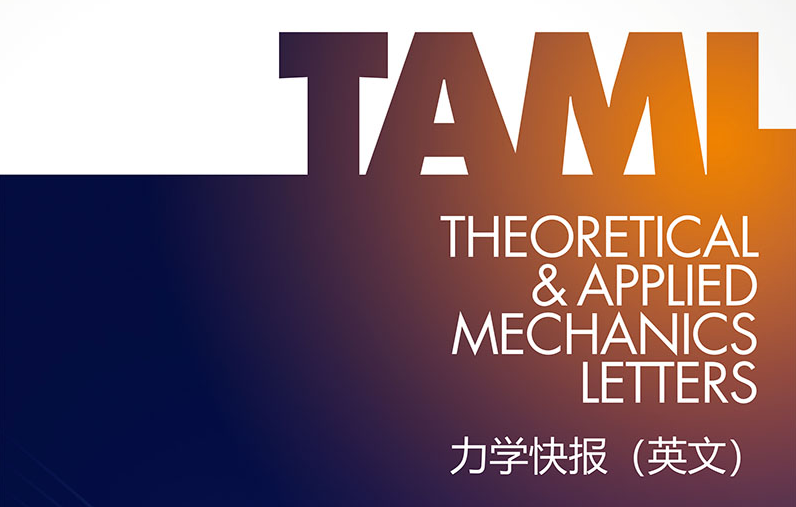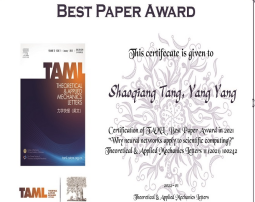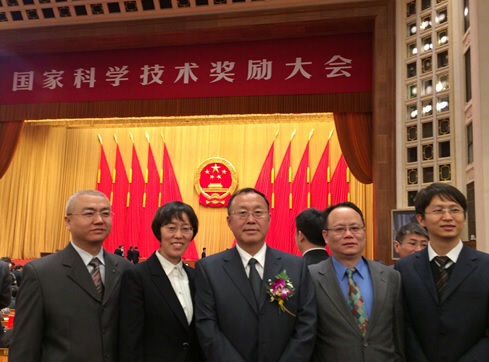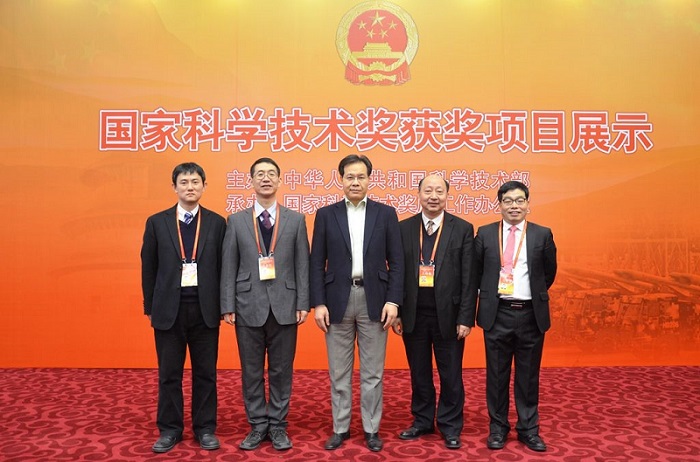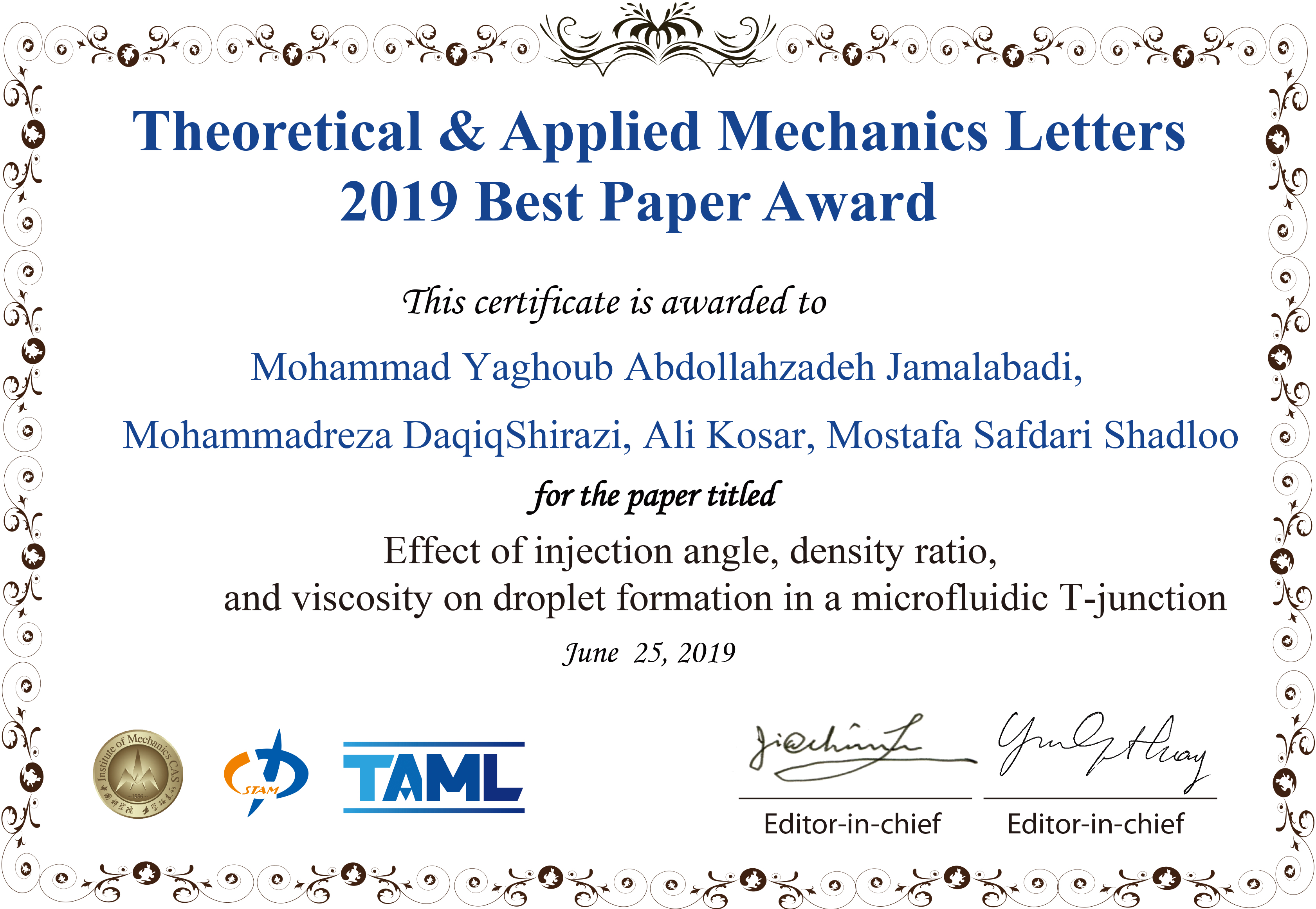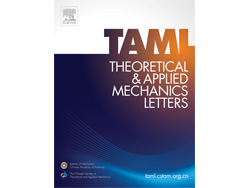Institute of Mechanics,
Chinese Academy of Sciences
2024 Vol.14(3)
Display Mode: |
Theoretical and Applied Mechanics Letters 14 (2024) 100516.
doi: 10.1016/j.taml.2024.100516
Abstract:
A numerical study of linear wave scattering over a floating platform has been simulated by an efficient numerical model in this letter. The non-hydrostatic model is used to simulate the free surface and the uneven bottom. For the solid body modelling, the immersed boundary method (IBM) is implemented by introducing a virtual boundary force into the momentum equations to emulate the boundary conditions. This implementation enhances the ability of the model to simulate interactions between waves and floating structures. A numerical case involving wave interactions with a floating platform is studied to validate the numerical model. By simulating the wave propagation, the numerical model captures the variation of the wave scattering very well, which verifies the performance of the numerical model and the robust strategy of the IBM.
A numerical study of linear wave scattering over a floating platform has been simulated by an efficient numerical model in this letter. The non-hydrostatic model is used to simulate the free surface and the uneven bottom. For the solid body modelling, the immersed boundary method (IBM) is implemented by introducing a virtual boundary force into the momentum equations to emulate the boundary conditions. This implementation enhances the ability of the model to simulate interactions between waves and floating structures. A numerical case involving wave interactions with a floating platform is studied to validate the numerical model. By simulating the wave propagation, the numerical model captures the variation of the wave scattering very well, which verifies the performance of the numerical model and the robust strategy of the IBM.
Theoretical and Applied Mechanics Letters 14 (2024) 100519.
doi: 10.1016/j.taml.2024.100519
Abstract:
The present study proposes a sub-grid scale (SGS) model for the one-dimensional Burgers turbulence based on the neural network and deep learning method. The filtered data of the direct numerical simulation is used to establish the training data set, the validation data set, and the test data set. The artificial neural network (ANN) method and Back Propagation method are employed to train parameters in the ANN. The developed ANN is applied to construct the sub-grid scale model for the large eddy simulation (LES) of the Burgers turbulence in the one-dimensional space. The proposed model well predicts the time correlation and the space correlation of the Burgers turbulence.
The present study proposes a sub-grid scale (SGS) model for the one-dimensional Burgers turbulence based on the neural network and deep learning method. The filtered data of the direct numerical simulation is used to establish the training data set, the validation data set, and the test data set. The artificial neural network (ANN) method and Back Propagation method are employed to train parameters in the ANN. The developed ANN is applied to construct the sub-grid scale model for the large eddy simulation (LES) of the Burgers turbulence in the one-dimensional space. The proposed model well predicts the time correlation and the space correlation of the Burgers turbulence.
Theoretical and Applied Mechanics Letters 14 (2024) 100513.
doi: 10.1016/j.taml.2024.100513
Abstract:
Black phosphorus nanotubes (BPNTs) may have good properties and potential applications. Determining the vibration property of BPNTs is essential for gaining insight into the mechanical behaviour of BPNTs and designing optimized nanodevices. In this paper, the mechanical behaviour and vibration property of BPNTs are studied via orthotropic cylindrical shell model and molecular dynamics (MD) simulation. The vibration frequencies of two chiral BPNTs are analysed systematically. According to the results of MD calculations, it is revealed that the natural frequencies of two BPNTs with approximately equal sizes are unequal at each order, and that the natural frequencies of armchair BPNTs are higher than those of zigzag BPNTs. In addition, an armchair BPNTs with a stable structure is considered as the object of research, and the vibration frequencies of BPNTs of different sizes are analysed. When comparing the MD results, it is found that both the isotropic cylindrical shell model and orthotropic cylindrical shell model can better predict the thermal vibration of the lower order modes of the longer BPNTs better. However, for the vibration of shorter and thinner BPNTs, the prediction of the orthotropic cylindrical shell model is obviously superior to the isotropic shell model, thereby further proving the validity of the shell model that considers orthotropic for BPNTs.
Black phosphorus nanotubes (BPNTs) may have good properties and potential applications. Determining the vibration property of BPNTs is essential for gaining insight into the mechanical behaviour of BPNTs and designing optimized nanodevices. In this paper, the mechanical behaviour and vibration property of BPNTs are studied via orthotropic cylindrical shell model and molecular dynamics (MD) simulation. The vibration frequencies of two chiral BPNTs are analysed systematically. According to the results of MD calculations, it is revealed that the natural frequencies of two BPNTs with approximately equal sizes are unequal at each order, and that the natural frequencies of armchair BPNTs are higher than those of zigzag BPNTs. In addition, an armchair BPNTs with a stable structure is considered as the object of research, and the vibration frequencies of BPNTs of different sizes are analysed. When comparing the MD results, it is found that both the isotropic cylindrical shell model and orthotropic cylindrical shell model can better predict the thermal vibration of the lower order modes of the longer BPNTs better. However, for the vibration of shorter and thinner BPNTs, the prediction of the orthotropic cylindrical shell model is obviously superior to the isotropic shell model, thereby further proving the validity of the shell model that considers orthotropic for BPNTs.
Theoretical and Applied Mechanics Letters 14 (2024) 100514.
doi: 10.1016/j.taml.2024.100514
Abstract:
Repeated blast impacts on personnel in explosive environments can exacerbate craniocerebral trauma. Most existing studies focus on the injury effects of a single blast, lacking in-depth analysis on the injury effects and cumulative effects of repeated blasts. Therefore, rats were used as the experimental samples to suffer from explosion blasts with different peak air overpressures (167 kPa~482 kPa) and varying number of repeated blasts. The cumulative effect of craniocerebral trauma was most pronounced for moderate repeated blast, showing approximately 95% increase of trauma severity with penta blast, and an approximately 85% increase of trauma severity with penta minor blast. The cumulative effect of craniocerebral trauma from severe, repeated blast has a smaller rate of change compared to the other two conditions. The severity of trauma from penta blast increased by approximately 69% compared to a single blast. Comprehensive physiological, pathological and biochemical analysis show that the degree of neurological trauma caused by repeated blasts is higher than that of single blasts, and the pathological trauma to brain tissue is more extensive and severe. The trauma degree remains unchanged after double blast, increases by one grade after triple or quadruple blast, and increases by two grades after penta blast.
Repeated blast impacts on personnel in explosive environments can exacerbate craniocerebral trauma. Most existing studies focus on the injury effects of a single blast, lacking in-depth analysis on the injury effects and cumulative effects of repeated blasts. Therefore, rats were used as the experimental samples to suffer from explosion blasts with different peak air overpressures (167 kPa~482 kPa) and varying number of repeated blasts. The cumulative effect of craniocerebral trauma was most pronounced for moderate repeated blast, showing approximately 95% increase of trauma severity with penta blast, and an approximately 85% increase of trauma severity with penta minor blast. The cumulative effect of craniocerebral trauma from severe, repeated blast has a smaller rate of change compared to the other two conditions. The severity of trauma from penta blast increased by approximately 69% compared to a single blast. Comprehensive physiological, pathological and biochemical analysis show that the degree of neurological trauma caused by repeated blasts is higher than that of single blasts, and the pathological trauma to brain tissue is more extensive and severe. The trauma degree remains unchanged after double blast, increases by one grade after triple or quadruple blast, and increases by two grades after penta blast.
Theoretical and Applied Mechanics Letters 14 (2024) 100495.
doi: 10.1016/j.taml.2024.100495
Abstract:
The projectile penetration process into concrete target is a nonlinear complex problem. With the increase of experiment data, the data-driven paradigm has exhibited a new feasible method to solve such complex problem. However, due to poor quality of experimental data, the traditional machine learning (ML) methods, which are driven only by experimental data, have poor generalization capabilities and limited prediction accuracy. Therefore, this study intends to exhibit a ML method fusing the prior knowledge with experiment data. The new ML method can constrain the fitting to experimental data, improve the generalization ability and the prediction accuracy. Experimental results show that integrating domain prior knowledge can effectively improve the performance of the prediction model for penetration depth into concrete targets.
The projectile penetration process into concrete target is a nonlinear complex problem. With the increase of experiment data, the data-driven paradigm has exhibited a new feasible method to solve such complex problem. However, due to poor quality of experimental data, the traditional machine learning (ML) methods, which are driven only by experimental data, have poor generalization capabilities and limited prediction accuracy. Therefore, this study intends to exhibit a ML method fusing the prior knowledge with experiment data. The new ML method can constrain the fitting to experimental data, improve the generalization ability and the prediction accuracy. Experimental results show that integrating domain prior knowledge can effectively improve the performance of the prediction model for penetration depth into concrete targets.
Theoretical and Applied Mechanics Letters 14 (2024) 100509.
doi: 10.1016/j.taml.2024.100509
Abstract:
Cellular structures are commonly used to design energy-absorbing structures, and origami structures are becoming a prevalent method of cellular structure design. This paper proposes a foldable cellular structure based on the Waterbomb origami pattern. The geometrical configuration of this structure is described. Quasi-static compression tests of the origami tube cell of this cellular structure are conducted, and load-displacement relationship curves are obtained. Numerical simulations are carried out to analyze the effects of aspect ratio, folding angle, thickness and number of layers of origami tubes on initial peak force and specific energy absorption (SEA). Calculation formulas for initial peak force and SEA are obtained by the multiple linear regression method. The degree of influence of each parameter on the mechanical properties of the single-layer tube cell is compared. The results show that the cellular structure exhibits negative stiffness and periodic load-bearing capacity, as well as folding angle has the most significant effect on the load-bearing and energy-absorbing capacity. By adjusting the design parameters, the stiffness, load-bearing capacity and energy absorption capacity of this cellular structure can be adjusted, which shows the programmable mechanical properties of this cellular structure. The foldability and the smooth periodic load-bearing capacity give the structure potential for application as an energy-absorbing structure.
Cellular structures are commonly used to design energy-absorbing structures, and origami structures are becoming a prevalent method of cellular structure design. This paper proposes a foldable cellular structure based on the Waterbomb origami pattern. The geometrical configuration of this structure is described. Quasi-static compression tests of the origami tube cell of this cellular structure are conducted, and load-displacement relationship curves are obtained. Numerical simulations are carried out to analyze the effects of aspect ratio, folding angle, thickness and number of layers of origami tubes on initial peak force and specific energy absorption (SEA). Calculation formulas for initial peak force and SEA are obtained by the multiple linear regression method. The degree of influence of each parameter on the mechanical properties of the single-layer tube cell is compared. The results show that the cellular structure exhibits negative stiffness and periodic load-bearing capacity, as well as folding angle has the most significant effect on the load-bearing and energy-absorbing capacity. By adjusting the design parameters, the stiffness, load-bearing capacity and energy absorption capacity of this cellular structure can be adjusted, which shows the programmable mechanical properties of this cellular structure. The foldability and the smooth periodic load-bearing capacity give the structure potential for application as an energy-absorbing structure.
Theoretical and Applied Mechanics Letters 14 (2024) 100517.
doi: 10.1016/j.taml.2024.100517
Abstract:
Conical origami structures are characterized by their considerable out-of-plane stiffness and energy-absorption capacity. Previous investigations have commonly focused on the static characteristics of these lightweight structures. However, efficient analysis of the natural vibrations of these structures is pivotal for designing conical origami structures with programmable stiffness and mass. In this paper, we propose a novel method to analyze the natural vibrations of such structures by combining a symmetric substructuring method (SSM) and a generalized eigenvalue analysis. SSM exploits the inherent symmetry of the structure to decompose it into a finite set of repetitive substructures. In doing so, we reduce the dimensions of matrices and improve the computational efficiency by adopting the stiffness and mass matrices of the substructures in the generalized eigenvalue analysis. The simulated results of pin-jointed models implemented using finite element analyses are used to validate the computational results of the proposed approach. Moreover, the parametric analysis of the structures demonstrates the influences of the number of segments along the circumference and the radii of the cone on the structural mass and natural frequencies of the structures. Furthermore, a comparison between six-fold and four-fold conical origami structures and the influence of various geometric parameters on their natural frequencies is presented. This work provides a strategy for efficiently analyzing the natural vibration of symmetric origami structures and has the potential to contribute to the efficient design and customization of origami structures with programmable stiffness.
Conical origami structures are characterized by their considerable out-of-plane stiffness and energy-absorption capacity. Previous investigations have commonly focused on the static characteristics of these lightweight structures. However, efficient analysis of the natural vibrations of these structures is pivotal for designing conical origami structures with programmable stiffness and mass. In this paper, we propose a novel method to analyze the natural vibrations of such structures by combining a symmetric substructuring method (SSM) and a generalized eigenvalue analysis. SSM exploits the inherent symmetry of the structure to decompose it into a finite set of repetitive substructures. In doing so, we reduce the dimensions of matrices and improve the computational efficiency by adopting the stiffness and mass matrices of the substructures in the generalized eigenvalue analysis. The simulated results of pin-jointed models implemented using finite element analyses are used to validate the computational results of the proposed approach. Moreover, the parametric analysis of the structures demonstrates the influences of the number of segments along the circumference and the radii of the cone on the structural mass and natural frequencies of the structures. Furthermore, a comparison between six-fold and four-fold conical origami structures and the influence of various geometric parameters on their natural frequencies is presented. This work provides a strategy for efficiently analyzing the natural vibration of symmetric origami structures and has the potential to contribute to the efficient design and customization of origami structures with programmable stiffness.
Theoretical and Applied Mechanics Letters 14 (2024) 100499.
doi: 10.1016/j.taml.2024.100499
Abstract:
Polygonal finite elements remain an attractive option in finite element analysis due to their flexibility in modeling arbitrary shapes compared to triangles. In this study, a pentagonal membrane element was developed with the strain approach for the first time. The element possesses invariance, and the equilibrium constraint was applied to the assumed strain field using corrective coefficients. Inspired by the advancing front technique, a pentagonal mesh was generated, and the mesh quality was enhanced with Laplacian smoothing. The performance of the developed pentagonal element was assessed in a few numerical tests, and the results revealed its suitability in modeling the bending of beams. Besides, the numerical results are enhanced when pentagonal elements are used in mesh transitions along boundaries to smoothen curved edges and capture distributed loads.
Polygonal finite elements remain an attractive option in finite element analysis due to their flexibility in modeling arbitrary shapes compared to triangles. In this study, a pentagonal membrane element was developed with the strain approach for the first time. The element possesses invariance, and the equilibrium constraint was applied to the assumed strain field using corrective coefficients. Inspired by the advancing front technique, a pentagonal mesh was generated, and the mesh quality was enhanced with Laplacian smoothing. The performance of the developed pentagonal element was assessed in a few numerical tests, and the results revealed its suitability in modeling the bending of beams. Besides, the numerical results are enhanced when pentagonal elements are used in mesh transitions along boundaries to smoothen curved edges and capture distributed loads.
Theoretical and Applied Mechanics Letters 14 (2024) 100506.
doi: 10.1016/j.taml.2024.100506
Abstract:
The relationship between the protective performance of flexible polymer material and material parameters (elastic modulus, viscosity coefficient) is explored, an impact collision motion equation between two bodies is established from the viscoelastic material constitutive, and the relationship between the kinematic response and the material parameters is obtained. Based on the Kelvin constitutive model, a theoretical model for impact between the protective body and the protected body is established, then the dynamic response is obtained. The feasibility of the model was verified by drop hammer experiment, and the material parameters (elastic modulus, viscosity coefficient) were obtained by formula. The model is discretized and the relationship between local impact response and material parameters is analyzed. The discussion results on the relationship between the impact response and the protective material performance indicate that adjusting the elastic modulus, viscosity coefficient, and thickness of the protective material can effectively improve protective effect.
The relationship between the protective performance of flexible polymer material and material parameters (elastic modulus, viscosity coefficient) is explored, an impact collision motion equation between two bodies is established from the viscoelastic material constitutive, and the relationship between the kinematic response and the material parameters is obtained. Based on the Kelvin constitutive model, a theoretical model for impact between the protective body and the protected body is established, then the dynamic response is obtained. The feasibility of the model was verified by drop hammer experiment, and the material parameters (elastic modulus, viscosity coefficient) were obtained by formula. The model is discretized and the relationship between local impact response and material parameters is analyzed. The discussion results on the relationship between the impact response and the protective material performance indicate that adjusting the elastic modulus, viscosity coefficient, and thickness of the protective material can effectively improve protective effect.
Theoretical and Applied Mechanics Letters 14 (2024) 100522.
doi: 10.1016/j.taml.2024.100522
Abstract:
To address the common issues of wrinkling, tearing, and uneven wall thickness in the actual sheet metal stamping process of the outer ring of needle roller bearings, this study analyzes critical technical indicators such as forming limits, thickness distribution, and principal strains in the forming process in detail. Three-dimensional models of the concave and convex dies were constructed. The effects of different process parameters, including stamping speed, edge pressure, sheet metal thickness, and friction coefficient, on the quality of the forming parts were investigated by varying these parameters. Subsequently, the orthogonal experimental method was used to determine an optimal experimental group from multiple sets of experiments. It was found that under the process parameters of a stamping speed of 3000 mm/s, edge pressure of 2000 N, sheet metal thickness of 0.9 mm, and friction coefficient of 0.125, the forming quality of the outer ring of the bearing is ideal.
To address the common issues of wrinkling, tearing, and uneven wall thickness in the actual sheet metal stamping process of the outer ring of needle roller bearings, this study analyzes critical technical indicators such as forming limits, thickness distribution, and principal strains in the forming process in detail. Three-dimensional models of the concave and convex dies were constructed. The effects of different process parameters, including stamping speed, edge pressure, sheet metal thickness, and friction coefficient, on the quality of the forming parts were investigated by varying these parameters. Subsequently, the orthogonal experimental method was used to determine an optimal experimental group from multiple sets of experiments. It was found that under the process parameters of a stamping speed of 3000 mm/s, edge pressure of 2000 N, sheet metal thickness of 0.9 mm, and friction coefficient of 0.125, the forming quality of the outer ring of the bearing is ideal.
 Submit a Paper
Submit a Paper
 Subscription
Subscription
News
MORE+
Call for Papers
MORE+
- Crossing-Mechanics Driven by Big Data
- Machine learning in the fluid mechanics research of wind energy
- Mechanics of Origami/Kirigami structures and metamaterials
- New insights and perspectives on impact biomechanics for human tissues: from injury prevention, protection to protective equipment
- Environmental Mechanics for Extreme Natural Events





